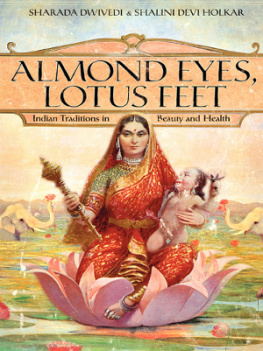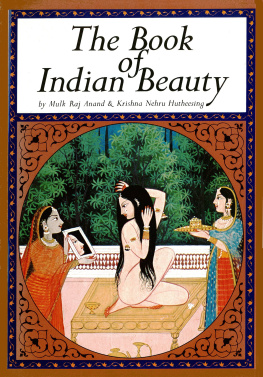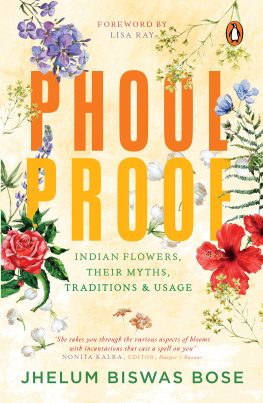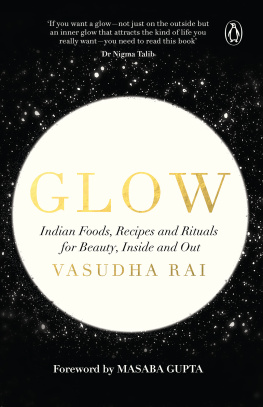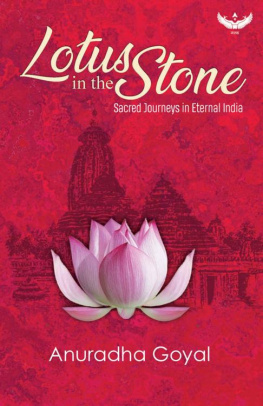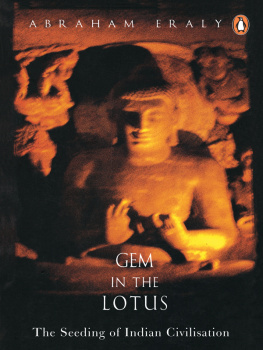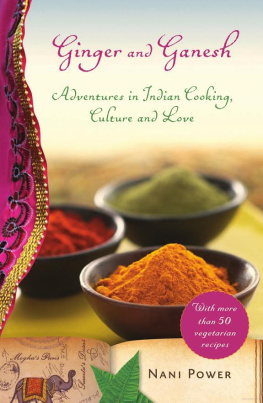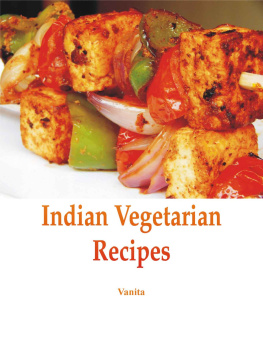Almond Eyes, Lotus Feet
Indian Traditions in Beauty and Health
Sharada Dwivedi Shalini Devi Holkar
With a Foreword by
Princess Esra Jah

For our daughters, Sabrina Holkar and Radhika Dwivedi with much love.
Contents
Foreword by Princess Esra Jah of Hyderabad
Marriage Mantra
Eve of Motherhood
Maternal Joys
Raising a Family
Crowning Glory
Bathing Beauty
Indulging the Body
Radiant Complexion
Myriad Fragrances
Bejeweled and Bedecked
Precious Memories
Recipes


Princess Esra Jah of Hyderabad
P RINCESS E SRA J AH OF H YDERABAD
Whenever I read an article written by people settled in other countries using flowery language I am a little suspicious of its sincerity. However, at risk of making the same mistake myself, I must say that I find most Indian women not only extremely beautiful but also appearing to possess great inner strength and wisdom.
For me, outside beauty must reflect what is inside and I have seen these qualities over and over again in many women during my time in India. They have taught me their patience and how to treat difficult moments in ones life as tests to be overcome. After twenty-five years away from India coming back was like returning home, my friendships as strong, warm, and supportive as if I had never left.
I find Indian women have great physical advantage. They are usually born with lovely eyes and teeth, beautiful hair and skin. I remember spending hours with my hair in coconut oil and my body in pastes made from special ingredients, trying to achieve the luxurious hair and smooth skin of those surrounding me.
In those days, it was fashionable in Europe to sunbathe for hours to get a tan, yet Indian women were trying to whiten their skin. Now, years later, they have come to realize how intrinsically beautiful they are, enabling them to win beauty competitions all over the world!
The graceful movements are seemingly inbred in all Indian women. To walk down a village road and see them carrying their wood piles or pots on their head is to realize the inborn grace they possess. They are courageous enough to wear the most brilliant colors, and on them it appears luxurious: all the colors provided by nature are displayed in their garments. Even the simplest sari looks elegant.
I have always loved the sari. When I was a young girl an Indian friend of my mothers was visiting us in Istanbul and I asked permission to see her saris. When she saw me looking at them with such joy she said, Well you must marry an Indian so that you can wear them. Little did she know that this would become true. When I married into the Hyderabad family my chance came to wear the sari and I loved it. In the beginning I wore them with difficulty but with the help of my friends I finally learned the art.
When Nizam VII died and my husband succeeded, one of my first visits was to the storerooms where the old materials and saris were kept. I felt as if I were in Aladdins cave: there were rolls of textiles, old costumes, and cupboards full of saris. But as I touched them, I found to my sorrow that most of them crumbled in my fingers due to years of not being aired. Luckily we managed to salvage at least some of them.
The more I look into the adornment of women the more I see the importance of taste in the use of jewelry. From ordinary silver anklets to the most lush jewelry in India there seems to be sophisticated taste, however humble or grand the wearer may be. The uncut form of stone used in Indian jewelry has a magnificence that cut stones do not possess. Indians seem to have an ability to mix colors, both in jewelry and in textiles, in ways that are exquisitely harmonized.
How strange it is to reflect that the young generation in India is now trying to copy Western dress, whereas Western fashion is looking toward ancient Indian inspiration for glamor.

P RINCESS E SRA J AH
L ONDON , 2005
They are all Padmini, all the women who shared with us their own ideas and expertise, the fruits of a long life of experience. As we have gathered from each of them to give to Padmini, so Padmini must give thanks to them.
Many have now left us, but we have fond memories of them all. To each of those wonderful people we offer a fragrant garland of gratitude: Qamar Ahmad, Ameneh Ahmed, Farida Ahmed, Baiji, Rajmata Pravin Kunverba, Princess Shri Kumari of Banswara, Durga Bhagvat, Princess Padma Lokur of Bhor, Minnie Boatawala, Vandana Chatterjee, Dr. Sharadini Dahanukar, Princess Shashiprabha Raje of Dhar, Maharani Brijraj Kumari of Dhrangadhara, Princess Sitaraje Ghatge, Lady Fay Holkar, Mayadevi Jain, Janaki Joshi, Sushila Joshi, Sati Kaul, Anjanabai Lolekar, Hansa Mariwala, Habiba Miranda, Leela Moolgaokar, Shanti Moti Chandra, Mayarani Mukherjee, Savitribai Nene, Indumati Phadke, Begum Maqbul Jehan of Palanpur, Maharani Perveen of Pratapgarh, Prema Ramakrishnan, Nirmala Sharma, Sonibai Shinde, Princess Vijayraj Kumari of Udaipur, Princess Rukmini Varma of Travancore, and Maharani Rama Kumari of Wankaner.
And to the men who helped us in many ways, a scented bouquet with many thanks: Dr. Ravindra Bapat, Appashaeb and Subhash Pethe, Sulaiman K. Shama, Brigadier K. C. Sharma, and Cory Wallia.
We are grateful to Rani Nirmala Raje Bhonsale of Baroda-Akalkot, Harsha Dehejia, Princess Shashiraje Wallia of Dewas Jr., Radhika Dwivedi, B. D. Garga, Hemlata Jain, Sangita Sinh Kathiwada, Jimmy Ollia, Geoffrey Roome, Azmat Syed, K. V. Talcherkar, and Princess Rukmini Verma of Travancore who were so generous with illustrations and offer them our heartfelt thanks.

Lord Ganesh
R ADHIKA D WIVEDI
A special word of appreciation to Suresh Cordo for his exceptional photographs of artifacts and Noshir Gobhai of the ingredients, to Farooq Issa of Phillips Antiques, who has always been so generous in sharing his vast collection of lithographs, postcards, photographs and company drawings and to Maharaja Ranjitsingh Gaekwad of Baroda, managing trustee of the Fatehsingh Museum Trust for permitting us to use images from their collection of Raja Ravi Varma paintings.
W e offer a lovely lotus to Anna Bliss and Cassie Jones of HarperCollins and a fragrant magnolia to Marc Gerald of The Agency Group who fortuitously discovered the book during a trip to India. We are grateful to Eminence Designs, who originally published the book in India.
Princess Esra Jah of Hyderabad, a true symbol of grace and beauty, very kindly agreed to write a personal and enchanting foreword to the book. We are grateful and offer her a special garland of fragrant wild roses!

Maharani Tara Devi of Kashmir
S URESH C ORDO
Granny, I love you dearly, but this book is a mess! Thats what my granddaughter said. I know what she meant: it is a hodgepodgepart first aid, part folklore, and part cookbook. I suppose in some places its a bit naughty tooI mean, I talk about sex and such things. But the way we were taught, theyre all interrelated. All the beauty secrets, the home remedies, and all the rituals I know at the age of seventy-five come from the same source: other women. I suppose that women practice these things for the same reasons: to keep everyone healthy and happy.

